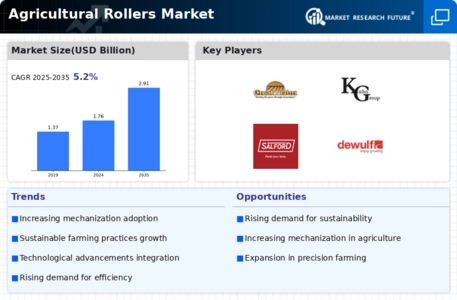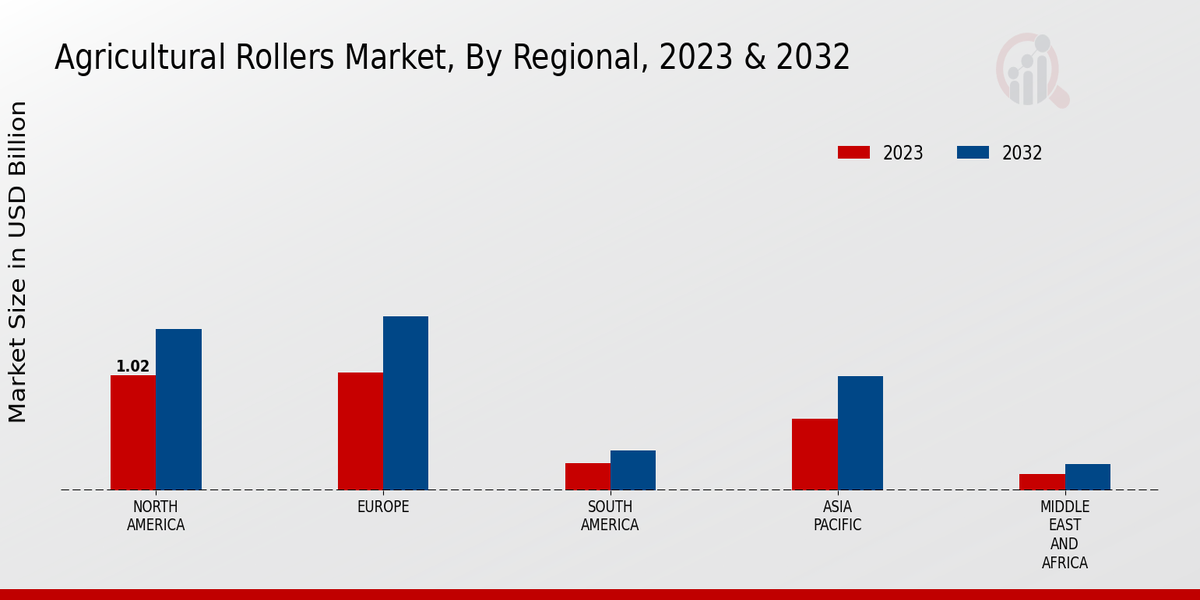Market Growth Projections
The Global Agricultural Rollers Market Industry is poised for substantial growth, with projections indicating a market value of 1.76 USD Billion in 2024 and an anticipated increase to 2.91 USD Billion by 2035. This growth trajectory reflects a CAGR of 4.67% from 2025 to 2035, underscoring the increasing adoption of agricultural rollers across various regions. The market dynamics are influenced by factors such as technological advancements, government support, and rising awareness of sustainable practices. As the agricultural sector evolves, the demand for efficient soil management solutions is likely to drive further investment and innovation in the agricultural rollers market.
Increasing Demand for High-Quality Crop Production
The Global Agricultural Rollers Market Industry experiences a notable surge in demand driven by the need for high-quality crop production. Farmers increasingly recognize the importance of soil preparation in enhancing crop yield and quality. Agricultural rollers play a crucial role in soil compaction and seedbed preparation, which are essential for optimal growth conditions. As the global population continues to rise, the pressure on agricultural output intensifies, leading to an estimated market value of 1.76 USD Billion in 2024. This trend suggests that investment in agricultural technology, including rollers, is likely to grow, reflecting a broader commitment to sustainable farming practices.
Rising Awareness of Soil Health and Sustainability
The growing awareness of soil health and sustainable farming practices significantly impacts the Global Agricultural Rollers Market Industry. Farmers are increasingly educated about the long-term benefits of maintaining soil integrity and fertility, leading to a greater emphasis on soil management techniques. Agricultural rollers contribute to these practices by ensuring proper soil compaction and reducing erosion. As sustainability becomes a priority for both consumers and producers, the demand for equipment that supports these goals is likely to rise. This trend aligns with the broader movement towards environmentally friendly agricultural practices, indicating a promising outlook for the market.
Technological Advancements in Agricultural Equipment
Technological innovations significantly influence the Global Agricultural Rollers Market Industry, as manufacturers integrate advanced features into their products. The introduction of precision agriculture technologies, such as GPS-guided rollers, enhances the efficiency and effectiveness of soil management practices. These advancements not only improve operational efficiency but also reduce labor costs and environmental impact. As a result, the market is projected to grow at a CAGR of 4.67% from 2025 to 2035, potentially reaching 2.91 USD Billion by 2035. This growth indicates a shift towards more sophisticated agricultural solutions that align with modern farming needs.
Expansion of Agricultural Land and Crop Diversification
The expansion of agricultural land and the diversification of crops are critical drivers of the Global Agricultural Rollers Market Industry. As farmers seek to maximize their yield potential, they often turn to agricultural rollers to prepare their fields effectively. This trend is particularly evident in developing regions where agricultural land is being converted for more intensive farming practices. The increasing variety of crops being cultivated necessitates specialized equipment, including rollers tailored for specific soil types and crop requirements. Consequently, this diversification is expected to bolster market growth, as farmers invest in technology that enhances productivity and efficiency.
Government Initiatives Supporting Agricultural Development
Government initiatives aimed at boosting agricultural productivity play a pivotal role in the Global Agricultural Rollers Market Industry. Various countries implement policies that promote the adoption of modern farming techniques, including the use of agricultural rollers. These initiatives often include subsidies, grants, and training programs for farmers to enhance their operational capabilities. For instance, in several regions, governments are investing in infrastructure improvements that facilitate the use of advanced agricultural equipment. Such support not only encourages farmers to invest in rollers but also contributes to the overall growth of the agricultural sector, fostering a more resilient food supply chain.
















Leave a Comment